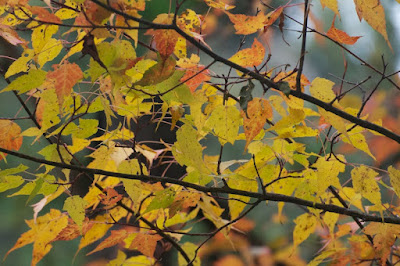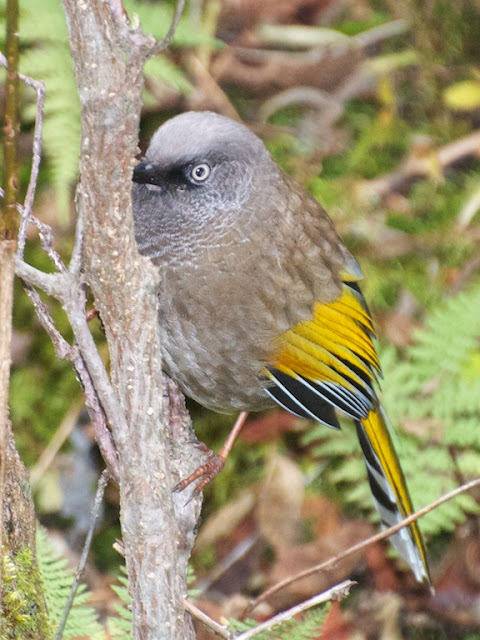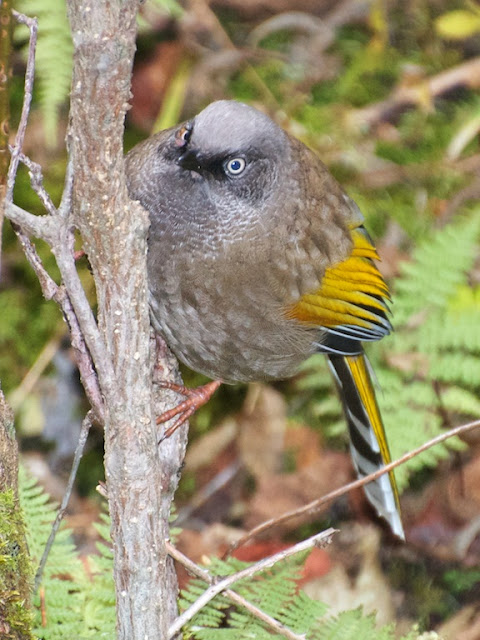Unfortunately, this lake, in the heart of the area devastated by the August 2017 earthquake, was severely damaged and is no longer accessible.
These photos are a memorial to a beauty that was.
The deep blue waters of the lake were crisscrossed by the moss-covered trunks of fallen trees, creating patterns that should have (and for all I know, perhaps have) inspired generations of textile weavers.
A White-throated Dipper (Cinclus cinclus) splashed into the water near the viewing platform, searching for insect larvae beneath the surface.
This is the same species as the Dipper of England; it ranges across Eurasia, its various races differing in the amount of white on the breast (some birds lack it altogether, creating an identification problem where the species overlaps with the purely Asian Brown Dipper (Cinclus pallasii).
Autumn foliage colours are richest where the diversity of maples is highest - as it is in Eastern Asia, and eastern North America. Maples, unlike most other deciduous trees, do not simply lose their chlorophyll to display whatever pigments lie beneath. Instead, they pump new pigments - anthocyanins - into their leaves in autumn as part of boosting their sugar supply. The results are the rich oranges, reds and even purples that give maple trees their variety of autumn colour.
So it was at Jiuzhaigou, where there are a number species of maples, including this one (and I am not sure which one this is).
So it was at Jiuzhaigou, where there are a number species of maples, including this one (and I am not sure which one this is).
After a lunch break at the (now nearly demolished) visitor centre, we spent the remainder of our day at Jiuzhaigou exploring the westernmost of the two roads leading into the valleys in the north of the park.
This road ends at Long Lake, and a truly spectacular view of the mountains in the distance.
While my companions took pictures around the lake...
This road ends at Long Lake, and a truly spectacular view of the mountains in the distance.
While my companions took pictures around the lake...
... I headed off into a nearby patch of brush in the hope of turning up at least one of the park's bird specialties. To my very great delight, I was successful. A party of tame and colourful Elliot's Laughingthrushes (Trochalopteron, or Garrulax, elliotii), undoubtedly the bird of the day, explored the undergrowth almost at my feet.
Mainland China, of course, is particularly rich in laughingthrushes, with some forty different species. Five are found nowhere else. Elliot's, confined to the eastern end of the Himalayan chain, is not one of them, but it comes pretty close (its range just extends over the border into northeastern India). This was my best chance of seeing it - and besides, what a gorgeous creature it is!
Laughingthrushes aside, I was torn between gazing up at the mountain peaks...
...and examining the trees and shrubs around me. One of the more attractive was Sorbus koehneana, variously called Chinese White-fruited Rowan or Koehne Mountain Ash. In North America we are used to trees of this genus being adorned with clusters of red orange berries, but the berries of a number of Asian species are white. This one is native to central China, but it is attractive enough to have been planted in gardens elsewhere.
From Long Lake we retraced our steps down the mountain, joining the crowds heading for one of the park's most popular attractions.
This is the Jade or Five Coloured Pool, so called because you can see five distinctive shades of blue in its crystalline waters. I hope that it still looks like this after the earthquake.
It is small but spectacular - no wonder the Chinese once believed that a goddess washed her hair in its waters.
Its colours, so the legend went, came from the rouge washed from the goddess's face. In fact they are the result of a combination of travertine sediments and algal growth covering the uneven surface of the lake bed.
This was pretty much our last stop at Jiuzhaigou. I'm glad to have seen it in its pristine state - and I am glad to hear that, in May 2018, the park will reopen its gates.
Mainland China, of course, is particularly rich in laughingthrushes, with some forty different species. Five are found nowhere else. Elliot's, confined to the eastern end of the Himalayan chain, is not one of them, but it comes pretty close (its range just extends over the border into northeastern India). This was my best chance of seeing it - and besides, what a gorgeous creature it is!
Laughingthrushes aside, I was torn between gazing up at the mountain peaks...
...and examining the trees and shrubs around me. One of the more attractive was Sorbus koehneana, variously called Chinese White-fruited Rowan or Koehne Mountain Ash. In North America we are used to trees of this genus being adorned with clusters of red orange berries, but the berries of a number of Asian species are white. This one is native to central China, but it is attractive enough to have been planted in gardens elsewhere.
From Long Lake we retraced our steps down the mountain, joining the crowds heading for one of the park's most popular attractions.
This is the Jade or Five Coloured Pool, so called because you can see five distinctive shades of blue in its crystalline waters. I hope that it still looks like this after the earthquake.
It is small but spectacular - no wonder the Chinese once believed that a goddess washed her hair in its waters.
Its colours, so the legend went, came from the rouge washed from the goddess's face. In fact they are the result of a combination of travertine sediments and algal growth covering the uneven surface of the lake bed.
This was pretty much our last stop at Jiuzhaigou. I'm glad to have seen it in its pristine state - and I am glad to hear that, in May 2018, the park will reopen its gates.













































No comments:
Post a Comment